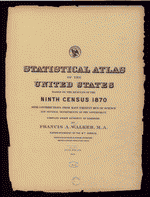History
Geography & Mapping

1870 Statistical Atlas
Maps are a unique way to study statistical information, making it very easy to compare data across geographic areas. They also provide a quick reference point that can be interpreted by almost anyone, regardless of educational level.
Nevertheless, for many years maps were a rarity in Census Bureau publications; before the advent of computer technology in the second half of the twentieth century, they could be painstakingly difficult to produce. The early highlight of map publication at the Census Bureau was at the end of the 19th and beginning of the 20th century, when Francis A. Walker and Henry Gannett published their statistical atlases. After Gannett left the Census Bureau, the atlases quickly fell by the wayside; the program was canceled for the 1930 census. Recently, however, cartography has become increasingly important to planning and operations for the decennial census enumeration process, with enumerators using increasingly detailed maps to precisely locate housing units.
From J.D.B. DeBow’s first regional map of the continental United States, to the development of the TIGER digital mapping system, to the new National Atlas, the Census Bureau has had an important role in the development of American cartography since the nineteenth century.

